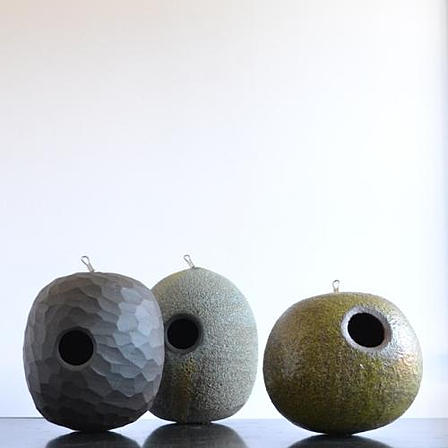A blog friend just scored a sweet piece of pottery while on vacation in the Midwest. Neither she nor I knew anything about the maker, and the label was almost worn away, but I'm an obsessive researcher, so I kept digging till I found out a few things. This post is for Rebecca.
Just after returning home after World War II, James Dryden met Norman Plummer, a ceramist and an employee of the Kansas Geological Survey. Plummer took Dryden to the best clay and ash fields in Kansas and introduced him to J. Sheldon Carey, head of the ceramics department at the University of Kansas.
After a crash course in ceramics, Dryden opened a pottery in his hometown of Ellsworth, Kansas, in 1946. From an early age, Dryden had been interested in art, and his mother had seen to it that he had lessons in drawing and painting. He had become an especially talented cartoonist, which he put to use designing signs and brochures for the company. College courses in chemistry had given him the tools needed to formulate glazes from Kansas ash.
The timing of his enterprise couldn't have been better. Because of the war, no one had been producing pottery for four years. Stores had no stock. Tourists had just started traveling again, so there was a market for souvenir ware and utilitarian household pieces. Soon he had customers like the Harvey Houses along the Santa Fe Railway, Macy’s of New York, and Van Briggle of Colorado Springs. Numerous souvenir shops ordered items with their names, so he devised a technique of inscribing bisque ware through unfired glaze with a dental drill.
By 1956, he realized that he needed to change locations, so he chose Hot Springs, Arkansas, which had a bustling tourist trade and more hotel rooms per capita that year than any other city in the U.S. In Kansas, his items were slip-cast, but in Hot Springs pressed pieces and thrown pottery were added. In the early Arkansas years, all materials were locally--clay from Malvern, talc from Bryant, and quartz from the Ouachitas. In later years, commercial clay has been used.
Markings vary greatly. Some include a form number and a hand-inscribed "Dryden." Many do not have a form number. A few have a block-printed company name. Pottery made in Kansas in 1954–55 for Van Briggle of Colorado is marked “Anna Van.”
In Arkansas, Dryden has employed hundreds of artists who have thrown on the wheel or decorated pottery. They have sometimes initialed and dated their work. Examples are "Maij-Lis" by May Lis Foster from 1961-61 and "ARS" by Arval R. Sanders in the 1970s. Dryden's son James Kimberly (generally known as Kimbo) was the first to add the word "Original"
to the bottoms of thrown pieces. In the early 1970s, the words "Ozark Frontier"
were added to the company logo. Foil stickers can be found as well.
Drydenware was undervalued until it gained national attention in the 1990s. Now the value is steadily increasing. The company is still in business and offering tours in Hot Springs after 68 continuous years producing pottery. The hallmark of Drydenware is the variety and beauty of its glazes.
G. L. Dybwad and Joy V. Bliss have written a book entitled
Dryden Pottery of Kansas and Arkansas, and their informative article
"Dryden Pottery--An Arkansas Treasure" contains much more information about the subject than I have offered here.
From bookstopshere.com
 |
Rebecca's beautiful vase, with partial sticker
midcenturymodernremodel.com |
 |
| ebay.com - cshcollectibles57 |
 |
| ebay.com - calvertcollection |
 |
| ebay.com - archaeologic |
 |
| ebay.com - jenpicked |
 |
| ebay.com - karenew20 |
 |
| ebay.com - herculean2005 |

































































